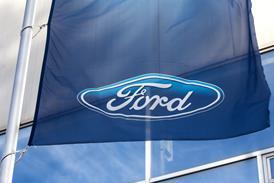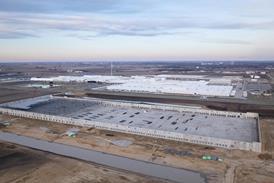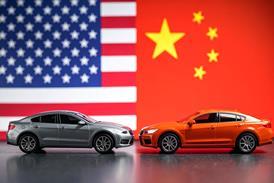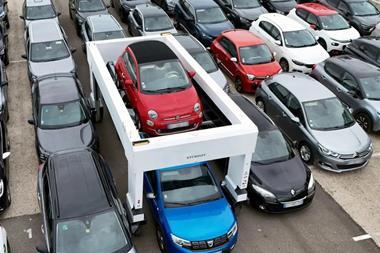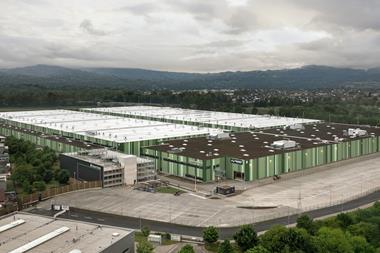China’s new road transport rules are prompting an evolution in the country’s vehicle logistics as suppliers redefine their networks to cope with changing truck limits – but investment is likely to be slow
In this story...
“Regulations on length and height were always in place, but no one followed them,” says Willi Li, managing director of BLG China, a subsidiary of Germany’s BLG Logistics. By some estimates, more than 99% of carriers in the country have been technically illegal – and some flagrantly so, with multiple trailers hitched to trucks carrying loads of 30 cars or more at once.
Savings in transport easily offset the costs of any fines. It made companies such as BLG, Gefco and other foreign logistics companies in China hesitant to invest in the local finished vehicle transport market for fear of violation or being unable to compete.
However, while most would agree with the need to improve safety, there are concerns about how well the Chinese market is responding to the reduction in finished vehicle transport capacity that the recent introduction of the GB1589 regulation has brought about – a cut that comes as vehicle sales and production continue to rise.
After sales in China reached a record 28m passenger and commercial vehicles in 2016 – propelled by a tax cut on smaller engines – volume is forecast to grow at a slower pace, but still surpass 29m units this year.
As the new rules are phased in, carmakers, including Changan Ford, BMW, Qoros and others, together with their logistics providers, have been scrambling to find equipment, with freight rates on the rise. That has led OEMs in China to look again at their outbound distribution networks, including changing routes but also switching to rail or water transport where possible.
[sta_anchor id="1"]However, by the time the law comes into full effect in 2018, sales could be well above 30m units, and alternative modes are unlikely to be able to fill the gaps in capacity.
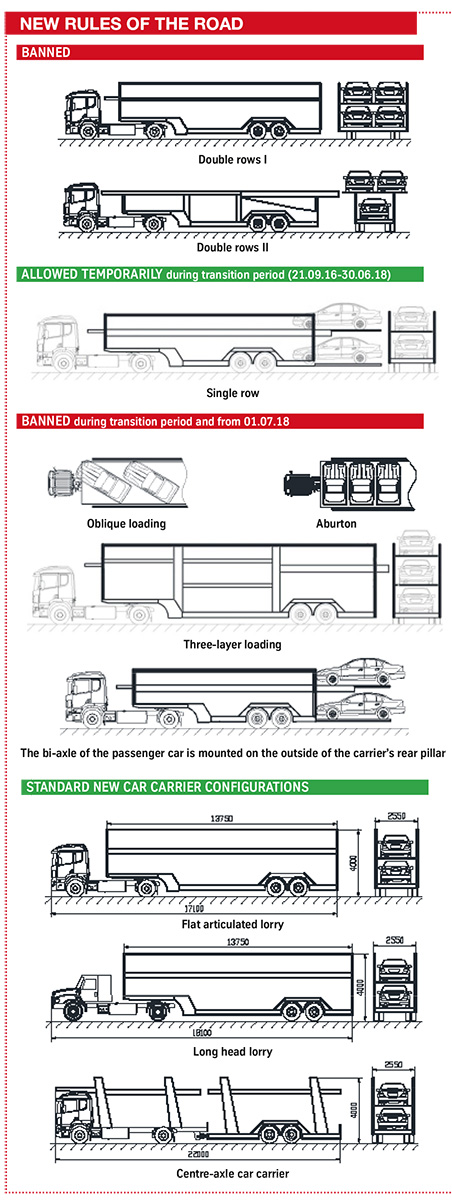 A new phase in Chinese logisticsThe new car carrier law regulates overall truck-trailer dimensions in China and the regulation is being implemented in two phases. Phase one, which came into effect in September 2016 and runs to June 2018, eliminates car transporters with double rows – essentially two semi-trailers connected side by side, pulled by a single central tractor. Double-row transporters handled between 21-24 cars on average, according to Willi Li.
A new phase in Chinese logisticsThe new car carrier law regulates overall truck-trailer dimensions in China and the regulation is being implemented in two phases. Phase one, which came into effect in September 2016 and runs to June 2018, eliminates car transporters with double rows – essentially two semi-trailers connected side by side, pulled by a single central tractor. Double-row transporters handled between 21-24 cars on average, according to Willi Li.
While only single-row carriers can now operate legally, there is no limitation on the length of car carriers during phase one (see chart, left). The caveat is that all of these trucks need to be registered officially, according to Chris Zuo, vice-secretary general at the China Automotive Logistics Association (CALA), an influential part of the government-linked China Federation of Logistics and Purchasing.
Zuo estimates that single carriers in China today hold about 12 vehicles on average. Oversized vehicles began the required registration in November 2016.
The next step is to eliminate these oversized vehicles gradually, with new maximum lengths to be introduced for various types of trucks by the end of the transition period. For flat tractors and semi-trailers, the length will be 17.1 metres, while the semi-trailer itself cannot exceed 13.75 metres. For long-head tractors, the maximum length will be 18.1 metres, including 13.75 metres for the trailer. Centre-axle trailers – the equipment expected to be used most for vehicle logistics in future – will have a limit of 22 metres.
From phase two, which will begin in July 2018, only car transporters that comply with the above dimensions will be permitted on the road – a short time period considering that so [sta_anchor id="2"]many of China’s tens of thousands of car-carrying trucks do not yet meet the new standards.
Falling capacity, rising costLaurent Sik, managing director of Gefco China, says that regulation GB1589 should enhance safety on the road and help to protect the environment. However, he also acknowledges that eliminating trucks that can carry 20 vehicles or more will mean a big cut in current capacity levels as logistics providers face reduced load factors, as well as significant cost rises across the sector.
CALA’s Zuo says double-row car carriers have already nearly vanished from China’s roads, and will have done so completely by the end of phase one. But the sector is already feeling the effects with rate rises of 30-60% as capacity tightens and providers struggle to find or train drivers.
Carmakers report a drop in capacity of 20-40%. Al Cardona, head of finished vehicle logistics and customs compliance at BMW China, for example, says trailer capacity across the industry has been reduced from official loading rates of ten units to eight, increasing unit cost.
“Carriers now are facing pressure to purchase more trailers in order to meet the capacity gap, and subcontractors are raising transportation fees,” says Cardona.
The real cut for many carmakers is probably greater. At Qoros, a Chinese-Israeli carmaker with a plant in Changshu, outside Shanghai, executives say the new regulations have already caused its truck capacity to decline by 40%. The capacity shortage has caused delays in transit for the past several months, according to Eric Wang, senior manager for vehicle logistics.
As the industry moves away from overloading, Zuo says companies are discovering efficiencies by making better use of equipment. For example, as most carriers are now moving smaller vehicle loads, each truck doesn’t need to distribute to as many dealers on each trip, and can thus handle more truckloads in the same timeframe.
Wang says Qoros has also been working with large logistics providers that might have more resources and capabilities at their disposal compared to smaller carriers. The OEM is furthermore setting up hubs to save consolidation time and shorten final delivery to dealerships.
“This year we expect to ship 50,000 units, so a hub would make sense,” explains Wang. “Because of the new regulations, the on-time delivery rate was down to 40% at most. After we took action, it came back to 90%, but it still falls short of our expectation.
“We knew that the new regulations would delay transportation, but the delay has been beyond our anticipation,” he says. In 2016, Qoros sold 24,000 vehicles, a rise of around 70% compared to 2015.
Laurent Sik at Gefco agrees that in-depth redesign of logistics networks is necessary, including the use of multi-client regional distribution centres. He also thinks truck capacity issues would be helped by OEMs increasing multimodal use, including rail, domestic short-sea along the coast, as well as inland waterways, such as the Yangtze River.
BLG’s Li agrees about the potential for multimodal transport. The double-row trucks that are being phased out, for example, were used overwhelmingly for long hauls of more than 500km. Li suggests that by eliminating such large trucks and payloads, there will be more opportunities for rail and water transport modes, since they tend to be most cost-effective for long-haul movements.
Chris Zuo says there are many signs that logistics companies in China are investing in other transport modes, notably ro-ro shipping. China’s local enterprises acquired seven new ships in 2015, and have discussed plans for around 30 vessels more over the coming years.
There has also been investment in rail; Zuo estimates that capacity levels in China’s rail wagon fleet have grown substantially, rising by around 50% between 2015 and 2016.
Qoros is already shipping 5-10% of its volume by the Yangtze River to Chongqing in south-western China, says Wang. BMW China, meanwhile, is testing rail and water transport routes.
“We have pilots ongoing from Tianjin to Chengdu by rail and from Shanghai to Wuhan and later to Chongqing via the Yangtze River,” says Al Cardona.
Sik also suggests that the use of the Eurasian rail link – which connects Europe to China via Russia or central Asia – could be an effective way for some manufacturers to reduce truck use to regions of China for imports. The logistics provider, which is majority-owned by Russian Railways, is among the forwarders offering services on the rail route.
Sik suggests that using this route for imports from Europe could save as many as 1,500km in truck transport when compared to sending European-built cars to the Chongqing region through the port of Guangzhou in south-east China; it would also reduce delivery time significantly.
It is a solution, however, that would only apply to a number of carmakers, most of them European premium brands, to support imports. OEMs like BMW, Audi and Mercedes-Benz [sta_anchor id="3"]build the majority of what they sell in China locally.
Taking centre stageAs the new car carrier regulations come into effect across China, centre-axle trailers are already becoming operational. This type of equipment is designed to load 8-11 cars, although it varies by model and body type. The dimensions are 22 metres in length, with a limit of 12 metres on the trailer part, 2.55 metres width, and 4 metres in height.
Chris Zuo says that China is considering more than 20 models of centre-axle trailers for production and sale in the country, the first of which was approved in November 2016. The government is likely to approve other car-carrier models gradually over the coming months and years. CALA expects about 15,000 centre-axle trailers to enter the market gradually in the coming years – representing about 30% of the entire fleet of car carriers.
 "Because of the new regulations, the on-time delivery rate was down to 40% at most... We knew that [they] would delay transportation, but the delay has been beyond our anticipation." - Eric Wang, Qoros Auto
"Because of the new regulations, the on-time delivery rate was down to 40% at most... We knew that [they] would delay transportation, but the delay has been beyond our anticipation." - Eric Wang, Qoros Auto
Gefco’s Sik points out that this type of equipment would align China more closely with western standards. “With a 22-metre length on centre-axle trailers, we are now getting closer to European standards, and reaching a load factor of seven or eight vehicles per truck,” he says.
BLG’s Li suggests that this equipment is also the safest available for car carriers. “Among the legal transporters that are growing in popularity, centre-axle trailers will provide better safety because of their greater flexibility for making turns,” he says.
However, though the equipment is longer and safer, Zuo predicts that the increasing use of centre-axle trailers will lead to price rises, as these trailers cost twice as much as the traditional ones used in China. “Since they use truck bodies as tractors, the original tractors could not be transformed into centre-axle trailers directly,” he says.
Previously, the semi-trailer structure was simple and the modification cost was lower, for example. Now, the centre-axle trailer needs a hydraulic frame installed simultaneously, so the modification costs will be higher.
Eric Belton, managing director of car carrier manufacturer Lohr, estimates that up to 80,000 car carriers will need to be produced within the next two and a half years. The France-based manufacturer plans to expand its capacity in response.
“Lohr is establishing a new production facility in China in order to meet this demand. Our design now meets the latest known level of transport quality for cars,” Belton says.
Centre-axle trailer combinations should represent the vast majority of the carriers in use in the future, which is part of an industrial project currently underway for the company. However, Belton says that he cannot yet provide many details on the products that Lohr will build and distribute in China, except that it will aim to achieve the highest load factor [sta_anchor id="4"]possible under the new requirements.
Levelling the roadFor a number of foreign and western companies in China, the stricter enforcement and regulation of car carriers could be a way to level the playing field in the market.
For example, while it has previously been reluctant to invest in illegal equipment, the new regulations may enable BLG to become more active in China; currently it functions mostly as an intermediary for its parent company by facilitating contacts. Li says that BLG China is watching the new regulations and how they will influence the car haulier market, although he still sees investment as more of a long-term strategy. “At this point, we probably would not invest in the short or medium term,” he says.
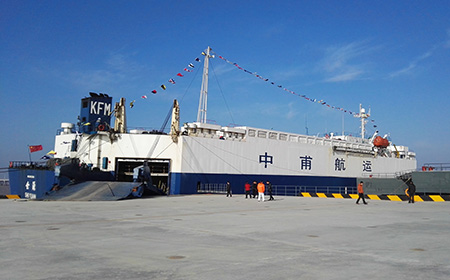
Gefco has also been cautious to invest in China with regulations so unclear. The company’s chief executive officer, Luc Nadal, has told Automotive Logistics that the new rules could encourage it to invest in vehicle logistics equipment together with local partners.
For trailer manufacturers such as Lohr, Belton also hopes that the new regulations will help bring fair competition, allowing the company to compete on legal products rather than selling to a market that habitually uses non-compliant equipment.
BMW’s Al Cardona is mainly concerned about whether enough companies are buying and building new equipment to match the incoming rules. “There are increasing transportation costs for us on a per unit basis,” he says. “In addition, there is also increased management cost due to more staff being needed to deal with the additional workload; smaller trailers equal a lot more moves.”
Cardona thinks that if railway and water shipments can handle a much bigger share of the transport volume, the increased cost from trucking can be offset. This will depend on the [sta_anchor id="5"]volume that is suitable for railway and water shipping modes, however.
Regulatory inconsistencyFurthermore, Cardona points out certain inconsistencies. Among them is the fact that Chinese provinces often have differing regulations on loading issues, such as vehicle overhang, and also enforce trailer dimensions differently.
“For the most part, provinces regulate that the last car body cannot exceed the last trailer post, which reduces the trailer loading capacity,” he says. “Furthermore, the regulations are not being applied consistently, since some provinces only permit six-unit trailers to enter beyond their toll-gates.”
Cardona says that weight limitation is also part of the trailer inspection focus. “In general, BMW’s carriers are adjusting their loading capacity and weight to meet the new regulations,” he says. But he points out that the new rules have also generated extra work; for example, now that there are a greater number of smaller trailers in use, the number of loads has increased and so BMW must track the delivery times to dealers more closely.
The changing regulations have also impacted BMW’s comprehensive load planning, which considers transport order release times, urgent deliveries, dealer location, and model mix, among other things. “In order to meet the requirements for trailer length and mass weight limits, we had to adjust the loading plan for both quantity and weight factors,” he notes.
Despite the extra work and costs, safety benefits are an important goal of the new regulations, which is something that Cardona supports. “Once the regulations are fully implemented, the overall highway safety conditions should improve with the absence of the very long or very wide trailers that were common in the past,” he says.
The new car carrier rules do much to raise the standards of finished vehicle transport regulation in China. The goal of improved safety offers a chance to reduce not only roadway accidents involving people, but also cargo damage. However, it remains to be seen to what extent carriers and OEMs will be able to meet the government’s deadlines, and whether they have the will and intention to comply fully with the new rules – overloading trucks, after all, has been a tough habit for carriers in China to break.











